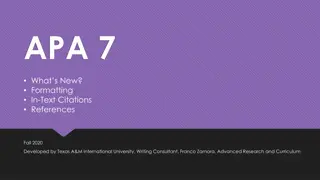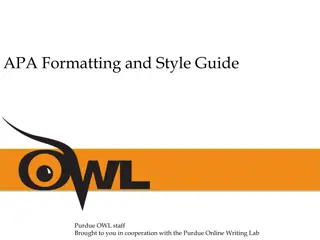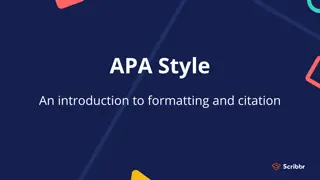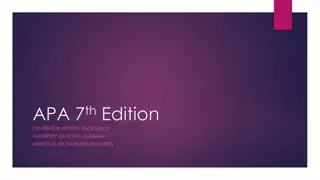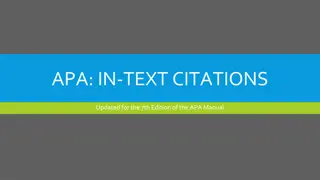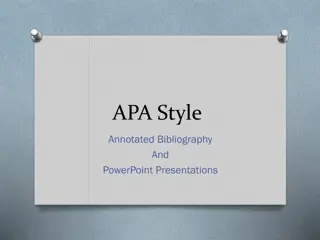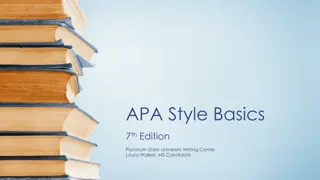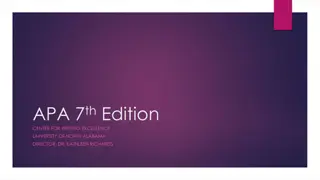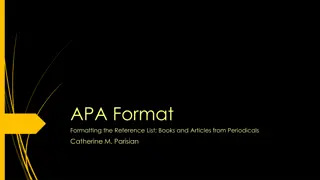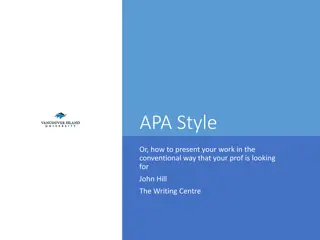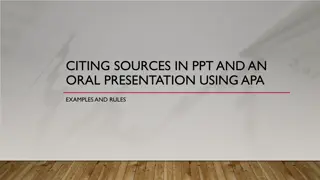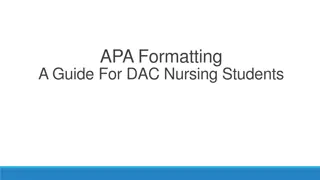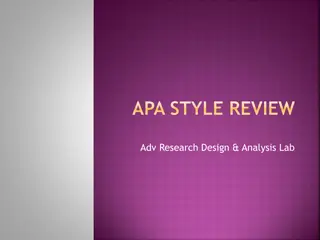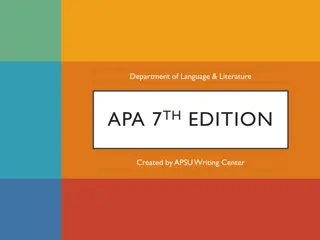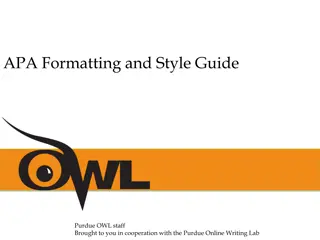Understanding APA Style Guidelines
APA Style, developed by the American Psychological Association, is commonly used in social sciences for manuscript formatting. It covers stylistics, in-text citations, references, point of view, voice, language clarity, types of APA papers - quantitative, qualitative, and literature review. Adhere to APA guidelines for clear, concise, and effective academic writing.
Download Presentation

Please find below an Image/Link to download the presentation.
The content on the website is provided AS IS for your information and personal use only. It may not be sold, licensed, or shared on other websites without obtaining consent from the author. Download presentation by click this link. If you encounter any issues during the download, it is possible that the publisher has removed the file from their server.
E N D
Presentation Transcript
APA Formatting and Style Guide Purdue OWL staff Brought to you in cooperation with the Purdue Online Writing Lab
What is APA Style? The American Psychological Association (APA) citation style is the most commonly used format for manuscripts in the social sciences. APA regulates: Stylistics In-text citations References
Point of View First-person pronouns rather than third-person : Weconducted an experiment : The authors conducted an experiment .
Voice Active voice when stressing the actions of the research : We askedparticipants questions. : The participants have been asked questions by the researchers. Passive voice when stressing the recipient or object of the action : The tests were inconclusive. : We found the tests inconclusive.
Language Language in an APA paper should be: Clear: be specific in descriptions and explanations Concise: condense information when you can Plain: use simple, descriptive adjectives and minimize figurative language
Types of APA Papers Quantitative Articles: Report quantitative research, which uses empirical and numerical information often analyzed through statistical means. Includes: Title Page Abstract Introduction Method Results Discussion
Types of APA Papers Qualitative Articles: Report qualitative research, which uses scientific practices to learn more about human experiences that cannot be numerically quantified. Includes: Title Page Abstract Introduction Method Findings/Results Discussion
Types of APA Papers The Literature Review: Summarizes scientific literature on a particular research topic While the APA Publication Manual does not require a specific order for a literature review, a good literature review typically contains the following components: Introduction Thesis statement Summary and synthesis of sources List of References
Types of APA Papers If your essay is not quantitative, qualitative, or a literature review: Consult the instructor Consult the APA Publication Manual
General APA Format Your essay should: Be typed Double-spaced Have 1 margins Use 10-12pt. Standard font (ex. Times New Roman) Be printed on standard-sized paper (8.5 x 11 )
General APA Format Every page of your essay should include: A page header (shortened title, all caps) in the upper left- hand corner The page number in the upper right
General APA Format Your essay should include four major sections: References Main Body Abstract Title page
Title Page Page header: (use Insert Page Header) Type Running head, then title flush left + page number flush right. Title: (in the upper half of the page, centered) name (no title or degree) + affiliation (university, etc.)
Abstract Page Shortened page header: do NOT include Running head: Abstract: centered, at the top of the page Write a 150- to 250- word summary of your paper in an accurate, concise, and specific manner.
Main Body (Text) Number the first text page as page number 3 Type and center the (full) title of the paper at the top of the page Type the text double-spaced with all sections following each other without a break Identify the sources you use in the paper with either narrative citations or parenthetical, in-text citations Format tables and figures
Reference Page Center the title (References) at the top of the page. Do not bold it. Double-space reference entries Flush left the first line of the entry and indent subsequent lines Order entries alphabetically by the surname of the first author of each work
References: Basics Invert authors names (last name first followed by initials) EX: Smith, J.Q. Capitalize only the first letter of the first word of a title and subtitle, the first word after a colon or a dash in the title, and proper nouns. Do not capitalize the first letter of the second word in a hyphenated compound word. EX: The perfectly formatted paper: How the Purdue OWL saved my essay.
References: Basics Capitalize all major words in journal titles Italicize titles of longer works such as books and journals Do not italicize, underline, or put quotes around the titles of shorter works such as journal articles or essays in edited collections
Making the Reference List APA is a complex system of citation. When compiling the reference list, the strategy below might be useful: 1. Identify the type of source: Is it a book? A journal article? A webpage? 2. Find a sample citation for this type of source Check a textbook or the OWL APA Guide: https://owl.purdue.edu/owl/research_and_citation/apa7_style/apa_f ormatting_and_style_guide/general_format.html 3. Mirror the sample 4. Make sure that the entries are listed in alphabetical order and that the subsequent lines are indented (Recall References: Basics)
In-text Citation: Basics In-text citations help readers locate the cited source in the References section of the paper. In-text citations follow either a parenthetical format or a narrative format. A parenthetical citation includes both the author s last name and year of publication, separated by a comma, in parentheses at the end of the sentence. EX: Research suggests that the Purdue OWL is a good resource for students (Atkins, 2018). A narrative citation includes the author s name directly in the sentence, with the year of publication directly following the author s last name. EX: Atkins (2018) suggests that the Purdue OWL is a good resource for students.
In-text Citation: Page Numbers If the source you re citing includes page numbers, add that information to your citation. For a parenthetical citation, the page number follows the year of publication, separated by a comma, and with a lowercase p and a period before the number (p.) EX: Research suggests that the Purdue OWL is a good resource for students (Atkins, 2018, p. 12). For a narrative citation, the page number comes at the end of the sentence, once again preceded by a lowercase p and a period (p.) EX: Atkins (2018) suggests that the Purdue OWL is a good resource for students (p. 12).
In-Text Citation: Quotations When quoting: Introduce the quotation with a signal phrase If using the parenthetical citation, include the author, date of publication, and page number at the end of the quotation. EX: As scientific knowledge advances, the application of CRISPR technology to improve human health is being explored across public and private sectors (Hong, 2018, p. 503). If using the narrative-style citation, include the author s last name in the signal phrase, with the page number at the end of the quote. EX: Hong (2018) stated that the application of CRISPR technology to improve human health is being explored across public and private sectors (p. 503).
In-Text Citation: Summary or Paraphrase Follow the same guidelines for parenthetical and narrative citations when summarizing or paraphrasing a longer chunk of text. Parenthetical citation: media use may not directly affect mental health; rather, it depends on how young adults use social media (Berryman, Ferguson, & Negy, 2018). EX: In one study that consisted of 467 young adults, it was found that social Narrative citation: their social media use and mental health and found that social media use may not directly affect mental health; rather, it depends on how young adults use social media. EX: Berryman, Ferguson, and Negy (2018) sampled 467 young adults about
In-Text Citation: Signal Words Introduce quotations with signal phrases, e.g.: According to Reynolds (2019), . (p. 3). Reynolds (2019) argued that (p. 3). Use signal verbs such as: acknowledged, contended, maintained, responded, reported, argued, concluded, etc. Use the past tense or the present perfect tense of verbs in signal phrases when they discuss past events.
In-Text Citation: Two or More Works When the parenthetical citation includes two or more works: Order them in the same way they appear in the reference list the author s name, the year of publication separated by a semi-colon. EX: Lorem ipsum dolor sit amet (Adams, 2018; Collins, 2017).
In-Text Citation: Works with Two Authors When citing a work with two authors: In the narrative citation,use and in between the authors names the occurrence and impacts of historical climatic hazards is critical to better interpret current hazard trends (p. 96). In the parenthetical citation, use & between names EX: According to scientists Depietri and McPhearson (2018), Understanding occurrence and impacts of historical climatic hazards is critical to better interpret current hazard trends (Depietri & McPhearson, 2018, p. 96). EX: When examining potential climate threats, Understanding the
In-Text Citation: Works with 3+ Authors When citing a work with three or more authors: list the name of the first author plus et al. in every citation. of the bikesharing program in Beijing. EX: Lin et. al (2019) examined how weather conditions affect the popularity bikesharing programs, specifically the Beijing Public Bikesharing Program (Lin et. al, 2019). EX: One study looked at how weather conditions affected the popularity of
In-Text Citation: Unknown Author When citing a work with an unknown author: Use the source s full title in the narrative citation. Cite the first word of the title followed by the year of publication in the parenthetical citation. EX: According to Here s How Gardening Benefits Your Health (2018) EX: ( Here s, 2018) Titles: Articles and Chapters = Books and Reports = italicize
In-Text Citation: Group Authors When citing a group author: Mention the organization the first time you cite the source in either the narrative citation or the parenthetical citation. If you first mention the group in a narrative citation, list the abbreviation before the year of publication in parentheses, separated by a comma. EX: The data collected by the Food and Drug Administration (FDA, 2019) confirmed If you first mention the group in a parenthetical citation, list the abbreviation in square brackets, followed by a comma and the year of publication. EX: (Food and Drug Administration [FDA], 2019).
In-Text Citation: Same Last Name/Author When citing authors with the same last names: Use first initials with the last names. EX: (B. Davis, 2018; Y. Davis, 2020) When citing two or more works by the same author and published in the same year: Use lower-case letters (a, b, c) after the year of publication to order the references. EX: Chen s (2018a) study of bird migration
In-Text Citation: Personal Communication When citing personal communication (interviews, letters, e-mails, etc.): Include the communicator s name, the fact that it was personal communication, and the date of the communication. Narrative citation: that many of her students had difficulties with APA style. EX: B. E. Anderson (personal communication, January 8, 2020) also claimed Parenthetical citation: APA style (Anderson, personal communication, January 8, 2020). EX: One teacher mentioned that many of her students had difficulties with Do not include personal communication in the reference list.
In-Text Citation: No Page Numbers When citing a text with no page numbers: parenthetical citation Use any of the following four methods List the heading or section name EX: One scientist noted that A cup full of kale can help your body out in a number of ways (London, 2019, Health benefits of kale section). List an abbreviated heading or section name in quotation marks (if the heading is too long) EX: One scientist noted that A cup full of kale can help your body out in a number of ways (London, 2019, Health benefits section). List the paragraph number EX: One scientist noted that A cup full of kale can help your body out in a number of ways (London, 2019, para. 2). List the heading or section name and the paragraph number EX: One scientist noted that A cup full of kale can help your body out in a number of ways (London, 2019, Health benefits of kale section, para. 2).
In-Text Citation: No Page Numbers When citing a text with no page numbers: narrative citation Use any of the following four methods List the heading or section name EX: Scientist Jaclyn London (2019, Health benefits of kale section) noted that A cup full of kale can help your body out in a number of ways. List an abbreviated heading or section name in quotation marks (if the heading is too long) EX: Scientist Jaclyn London (2019, Health benefits section) noted that A cup full of kale can help your body out in a number of ways. List the paragraph number EX: Scientist Jaclyn London (2019, para. 2) noted that A cup full of kale can help your body out in a number of ways. List the heading or section name and the paragraph number EX: Scientist Jaclyn London (2019, Health benefits of kale section, para. 2) noted that A cup full of kale can help your body out in a number of ways.
Headings APA uses a system of five heading levels (taken directly from the APA Publication Manual, 7th edition): APA Headings Level 1 Format Centered, Bold, Title Case Headings Text begins a new paragraph Flush Left, Bold, Title Case Heading Text begins as a new paragraph Flush Left, Bold Italic, Title Case Heading Text begins as a new paragraph Indented, Bold, Title Case Heading, Ending with a Period. Text begins on the same line and continues as a regular paragraph. Indented, Bold Italic, Title Case Heading, Ending with a Period. Text begins on the same line and continues as a regular paragraph. 2 3 4 5
Headings Here is an example of the five-level heading system:
Tables Label tables with an Arabic numeral and provide a brief but clear title. The label and title appear on separate lines above the table, flush-left and single-spaced. Cite a source in a note below the table. Table 1 Top 3 NBA Season Leaders 2019 Team Milwaukee Bucks Houston Rockets Dallas Mavericks Points Per Game 119.8 119.1 116.8 Note: This data was collected on December 31st, 2019. Retrieved from https://stats.nba.com/teams/
Figures Label figures with an Arabic numeral and provide a brief but clear title. The label and title appear on separate lines above the figure, flush-left and single-spaced. You might provide an additional title centered above the figure. Cite the source in a note below the figure. Figure 1. US Primary Energy Consumption by Energy Source, 2018
Additional Resources The Purdue OWL: http://owl.purdue.edu The Purdue Writing Lab @ Heavilon Hall 226 Composition textbooks Publication Manual of the American Psychological Association, 7th ed. APA s website: http://www.apastyle.org
The End APA Formatting and Style Guide Brought to you in cooperation with the Purdue Online Writing Lab



